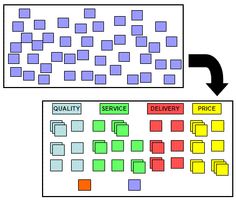# Affinistorming
### Brainstorming
- Gather in groups of 3-4 people
- Make a list of problems or ideas in which you want to go deeper or want to better visualize. The perfect job!
### Affinity Diagram
- Transfer brainstorming data into sticky notes
- Organize ideas in groups
- Assign headers and super-headers
- Pull out insightful quotes
- Digitize your Affinity Diagram [Realtime Board](https://realtimeboard.com/app/) or pictures ;)
:::success
- :+1: It is a good practice to digitize your deliverables so that they are legible and useful for the next exercises and presentations. :ballot_box_with_check: A great tool to do this is [Realtime Board](https://realtimeboard.com/app/) (I will be taking lots of pictures anyway!)
:::
## Brainstorming
> Results prove that if you have **real knowledge** in the subject you are brainstorming about, the results will be infinitely better.
With the data from your User Research and the emerging patterns fresh in your memory, it is time to take a glimpse of what the future of your project might hold!
It is natural that while doing your research and affinity diagram your brain has started to generate solutions, this brainstorming session will give you a quick chance to dump them all into a paper in order to organize your thoughts and free up mind space for the next exercises!
**Main principles for brainstorming:**
- Defer judgment
- Generate lots of ideas
- Encourage unusual ideas
- Combine ideas
1) The brainstorming topic
- It's fundamental that all members understand the problem you are trying to solve. Write it clearly on a post-it and stick it to the wall.
2) Think of all the words that come to your mind. Remember to move across two axis: personal-professional and appealing-unappealing but from the 'I' perspective
4) Write a list of the ideas and words
:::info
⏰ I will set a timer for a streamlining the process and not delay it over time, but if the timer is over and you (or your team) are feeling creative and with more energy. Just add more time and keep brainstorming!
:::
## Tips and tricks
**Here are some tricks that we think will be useful to you when *brainstorming*:**
- Include **ALL** ideas during the brainstorming session
- Don't think about solving a problem all the time. Think about problems, challenges, solutions, activities, tools, facts, etc.
- If you run out of ideas, take 2 minutes and look at what you’ve drawn
- Try to empathize with your colleague, boss, customer: How would you think about this problem if you were a different gender? If you were older? Younger? A different race or nationality? What if you were completely insane?
- Reverse brainstorming: try to think about the causes of the situation instead of the solutions. What are these causes? What's the source of the problem? How can it be solved?
- Assumption Flipping: If your assumption is that “People love listening to podcasts” flip it into “People do NOT love podcasts” Where will this lead to?
- Deepen the ideas of your colleagues, use them as a base and find possible ideas that complement each other
- Using mind maps can help Brainstorming sessions
## Affinity Diagram
Remember: the Affinity Diagram's goal is to organize perspectives and points of view into groups or issues.
1) **Transfer Data:** Go through your brainstorming and write the ideas on post-its in one/two words. Write down each finding on a different sticky note.
2. **Pull out insightful quotes**
While you look through your brainstorming data, highlight any important direct QUOTES that can give us insight into needs and pain points
3) **Display the sticky notes:** Post all the sticky notes on a large wall, a whiteboard, or a table - in a random manner

4) **Sort the ideas into related groups to find emerging patterns:** Physically sort the cards into groupings, without talking
5) **Create header cards for the groups:** A header captures the essential link among the ideas contained in a group of cards

6) **Finish up the diagram (take pictures and digitize)**
- Write the topic or subject at the top of the diagram
- Place headers and super-header sticky notes above the idea groups
7) **Find opportunities and discuss with your team**

:::info
:white_check_mark: Once you are done with your first affinity diagram, you can write down your insights and document them, and then you can start all over and rearrange the data to see what other patterns may emerge!
:::